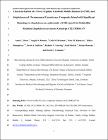| dc.contributor.author | COLEMAN, DAVID | en |
| dc.date.accessioned | 2011-05-19T16:09:02Z | |
| dc.date.available | 2011-05-19T16:09:02Z | |
| dc.date.issued | 2011 | en |
| dc.date.submitted | 2011 | en |
| dc.identifier.citation | SHORE, A.C., ROSSNEY, A.S., BRENNAN, O.M., KINNEVEY, P., HUMPHREYS, H., SULLIVAN, D.J., GOERING, R.V., EHRICHT, R., MONECKE, S., COLEMAN, D.C., CHARACTERIZATION OF A NOVEL ARGININE CATABOLIC MOBILE ELEMENT (ACME) AND STAPHYLOCOCCAL CHROMOSOMAL CASSETTE mec COMPOSITE ISLAND WITH SIGNIFICANT HOMOLOGY TO STAPHYLOCOCCUS EPIDERMIDIS ACME TYPE II IN METHICILLIN-RESISTANT STAPHYLOCOCCUS AUREUS GENOTYPE ST22-MRSA-IV, ANTIMICROBIAL AGENTS AND CHEMOTHERAPY, 55, 5, 2011, 1896 - 1905 | en |
| dc.identifier.other | Y | en |
| dc.identifier.uri | http://hdl.handle.net/2262/55775 | |
| dc.description | PUBLISHED | en |
| dc.description | 22 February, Epub ahead of print | en |
| dc.description.abstract | The arginine catabolic mobile element (ACME) is prevalent among ST8-MRSA-IVa (USA300) isolates and evidence suggests that ACME enhances the ability of ST8-MRSA-IVa to grow and survive on its host. ACME has been identified in a small number of isolates belonging to other MRSA clones but is widespread among coagulase-negative staphylococci (CoNS). This study reports the first description of ACME in two distinct strains of the pandemic ST22-MRSA-IV clone. A total of 238 MRSA isolates recovered in Ireland between 1971 and 2008 were investigated for ACME using a DNA microarray. Twenty-three isolates (9.7%) were ACME-positive, all were either MRSA genotype ST8-MRSA-IVa (7/23, 30%) or ST22-MRSA-IV (16/23, 70%). Whole-genome sequencing and comprehensive molecular characterization revealed the presence of a novel 46-kb ACME and SCCmec composite island (ACME/SCCmec-CI) in ST22-MRSA-IVh isolates (n = 15). This ACME/SCCmec-CI consists of a 12-kb DNA region previously identified in ACME type II in S. epidermidis ATCC 12228, a truncated copy of the J1 region of SCCmec I and a complete SCCmec IVh element. The composite island has a novel genetic organization with ACME located within orfX and SCCmec located downstream of ACME. One pvl-positive ST22-MRSA-IVa isolate carried ACME located downstream of SCCmec IVa as previously described in ST8-MRSA-IVa. These results suggest that ACME has been acquired by ST22-MRSA-IV on two independent occasions. At least one of these instances may have involved horizontal transfer and recombination events between MRSA and CoNS. The presence of ACME may enhance dissemination of ST22-MRSA-IV, an already successful MRSA clone. | en |
| dc.description.sponsorship | Microbiology Research Unit, Dublin Dental University Hospital | en |
| dc.format.extent | 1896 | en |
| dc.format.extent | 1905 | en |
| dc.language.iso | en | en |
| dc.relation.ispartofseries | ANTIMICROBIAL AGENTS AND CHEMOTHERAPY | en |
| dc.relation.ispartofseries | 55 | en |
| dc.relation.ispartofseries | 5 | en |
| dc.rights | Y | en |
| dc.subject | ACME | en |
| dc.subject | ST22-MRSA-IV | en |
| dc.subject | SCCmec | en |
| dc.subject | ST8-MRSA-IVa/USA300 | en |
| dc.subject | DNA microarray | en |
| dc.title | CHARACTERIZATION OF A NOVEL ARGININE CATABOLIC MOBILE ELEMENT (ACME) AND STAPHYLOCOCCAL CHROMOSOMAL CASSETTE mec COMPOSITE ISLAND WITH SIGNIFICANT HOMOLOGY TO STAPHYLOCOCCUS EPIDERMIDIS ACME TYPE II IN METHICILLIN-RESISTANT STAPHYLOCOCCUS AUREUS GENOTYPE ST22-MRSA-IV | en |
| dc.type | Journal Article | en |
| dc.type.supercollection | scholarly_publications | en |
| dc.type.supercollection | refereed_publications | en |
| dc.identifier.peoplefinderurl | http://people.tcd.ie/dcoleman | en |
| dc.identifier.rssinternalid | 71126 | en |
| dc.subject.TCDTheme | Immunology, Inflammation & Infection | en |
| dc.identifier.rssuri | http://dx.doi.org/10.1128/AAC.01756-10 | en |
| dc.identifier.rssuri | http://www.ncbi.nlm.nih.gov/entrez/query.fcgi?cmd=Retrieve&db=PubMed&list_uids=21343442&dopt=Abstract | en |
| dc.identifier.orcid_id | 0000-0003-1797-2888 | en |
| dc.contributor.sponsor | Health Research Board (HRB) | en |
| dc.contributor.sponsorGrantNumber | TRA/2006/4 | en |




